Eastern European Peasant Infantry, 15th Century
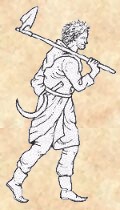 Source not given, 15th Century.
Source not given, 15th Century.
|
Balkan Cavalryman, 15th Century
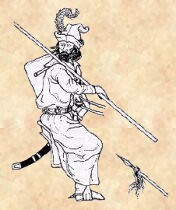 From William Caorsin's 'Obsidionis Rhodiae Descripto', printed in Ulm in 1496.
From William Caorsin's 'Obsidionis Rhodiae Descripto', printed in Ulm in 1496.
|
Albanian Cavalry, 15th Century
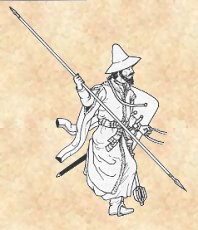 Source not given, 15th Century. Armour, where worn comprises no more than a mail corselet worn under the coat, common weapons include lance, mace, and sword or sabre ('which is a terrible weapon' says Philippe de Commynes).
Source not given, 15th Century. Armour, where worn comprises no more than a mail corselet worn under the coat, common weapons include lance, mace, and sword or sabre ('which is a terrible weapon' says Philippe de Commynes).
|
Roumanian Infantry, 15th Century
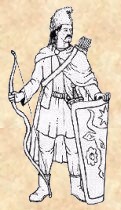 Source not given, 15th Century. This figure is a Moldavian of Stephen the Great's reign (1457-1504).
Source not given, 15th Century. This figure is a Moldavian of Stephen the Great's reign (1457-1504).
|
Roumanian Cavalry, 15th Century
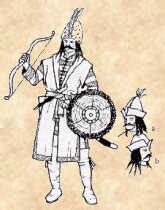 Source not given, 15th Century. This Wallacian holds an osier shield of native type, others might use Hungarian 'wing' shields like the next figure.
Source not given, 15th Century. This Wallacian holds an osier shield of native type, others might use Hungarian 'wing' shields like the next figure.
|
Roumanian Heavy Cavalry, 15th Century
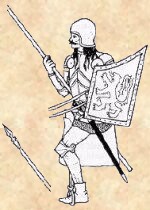 Based on a Moldavian Reliquary, 15th Century. Transylvanian heavy cavalry more armour, often full western plate (often German Gothic in style) with shields, see the Hungarian Men-at-Arms below.
Based on a Moldavian Reliquary, 15th Century. Transylvanian heavy cavalry more armour, often full western plate (often German Gothic in style) with shields, see the Hungarian Men-at-Arms below.
|
Hungarian Man-at-Arms, c.1445
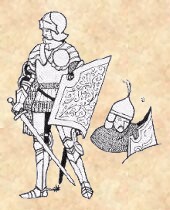 From an Italian fresco c.1445-50 depicting Florentine condottiere Filippo Scolari (aka Pippo Spano). Helmet and shield have been added from other sources, the 'wing' shield being very popular in Hungary and subsequently addopted by the Ottomans by the 16th Century.
From an Italian fresco c.1445-50 depicting Florentine condottiere Filippo Scolari (aka Pippo Spano). Helmet and shield have been added from other sources, the 'wing' shield being very popular in Hungary and subsequently addopted by the Ottomans by the 16th Century.
|
Hungarian Man-at-Arms, c.1487
 From the tomb effigy of Imricha Zapolyai, shows a Gothic harness that betrays some Italian influence in the tassets and breastplate. The single feather crest is seen in a considerable number of Hungarian sources and seems to have been used to denote men of rank.
From the tomb effigy of Imricha Zapolyai, shows a Gothic harness that betrays some Italian influence in the tassets and breastplate. The single feather crest is seen in a considerable number of Hungarian sources and seems to have been used to denote men of rank.
|
Hungarian or Serbian Hussar, late 15th Century
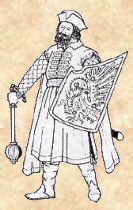 This figure wears a long sleeved tunic, and a topcoat with hanging Albanian style sleeves, and an 'Hungarian' cap.
This figure wears a long sleeved tunic, and a topcoat with hanging Albanian style sleeves, and an 'Hungarian' cap.
|
Hungarian or Serbian Hussar, late 15th Century
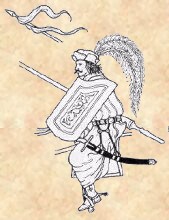 From an engraved sabre-scabbard chape of c.1500. Possibly from the Serbian gusar or husar, meaning a robber or plunderer.
From an engraved sabre-scabbard chape of c.1500. Possibly from the Serbian gusar or husar, meaning a robber or plunderer.
|
Mercenary Balkan Gunner, c.1526
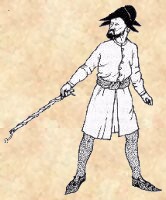 Ottoman ms. c.1526. Ottoman gunners were drawn from diverse sources, including Germans, Hungarians, Bosnians, Dalmatians and Italians.
Ottoman ms. c.1526. Ottoman gunners were drawn from diverse sources, including Germans, Hungarians, Bosnians, Dalmatians and Italians.
|

 Source not given, 15th Century.
Source not given, 15th Century.
 From William Caorsin's 'Obsidionis Rhodiae Descripto', printed in Ulm in 1496.
From William Caorsin's 'Obsidionis Rhodiae Descripto', printed in Ulm in 1496.
 Source not given, 15th Century. Armour, where worn comprises no more than a mail corselet worn under the coat, common weapons include lance, mace, and sword or sabre ('which is a terrible weapon' says Philippe de Commynes).
Source not given, 15th Century. Armour, where worn comprises no more than a mail corselet worn under the coat, common weapons include lance, mace, and sword or sabre ('which is a terrible weapon' says Philippe de Commynes).
 Source not given, 15th Century. This figure is a Moldavian of Stephen the Great's reign (1457-1504).
Source not given, 15th Century. This figure is a Moldavian of Stephen the Great's reign (1457-1504).
 Source not given, 15th Century. This Wallacian holds an osier shield of native type, others might use Hungarian 'wing' shields like the next figure.
Source not given, 15th Century. This Wallacian holds an osier shield of native type, others might use Hungarian 'wing' shields like the next figure.
 Based on a Moldavian Reliquary, 15th Century. Transylvanian heavy cavalry more armour, often full western plate (often German Gothic in style) with shields, see the Hungarian Men-at-Arms below.
Based on a Moldavian Reliquary, 15th Century. Transylvanian heavy cavalry more armour, often full western plate (often German Gothic in style) with shields, see the Hungarian Men-at-Arms below.
 From an Italian fresco c.1445-50 depicting Florentine condottiere Filippo Scolari (aka Pippo Spano). Helmet and shield have been added from other sources, the 'wing' shield being very popular in Hungary and subsequently addopted by the Ottomans by the 16th Century.
From an Italian fresco c.1445-50 depicting Florentine condottiere Filippo Scolari (aka Pippo Spano). Helmet and shield have been added from other sources, the 'wing' shield being very popular in Hungary and subsequently addopted by the Ottomans by the 16th Century.
 From the tomb effigy of Imricha Zapolyai, shows a Gothic harness that betrays some Italian influence in the tassets and breastplate. The single feather crest is seen in a considerable number of Hungarian sources and seems to have been used to denote men of rank.
From the tomb effigy of Imricha Zapolyai, shows a Gothic harness that betrays some Italian influence in the tassets and breastplate. The single feather crest is seen in a considerable number of Hungarian sources and seems to have been used to denote men of rank.
 This figure wears a long sleeved tunic, and a topcoat with hanging Albanian style sleeves, and an 'Hungarian' cap.
This figure wears a long sleeved tunic, and a topcoat with hanging Albanian style sleeves, and an 'Hungarian' cap.
 From an engraved sabre-scabbard chape of c.1500. Possibly from the Serbian gusar or husar, meaning a robber or plunderer.
From an engraved sabre-scabbard chape of c.1500. Possibly from the Serbian gusar or husar, meaning a robber or plunderer.
 Ottoman ms. c.1526. Ottoman gunners were drawn from diverse sources, including Germans, Hungarians, Bosnians, Dalmatians and Italians.
Ottoman ms. c.1526. Ottoman gunners were drawn from diverse sources, including Germans, Hungarians, Bosnians, Dalmatians and Italians.
